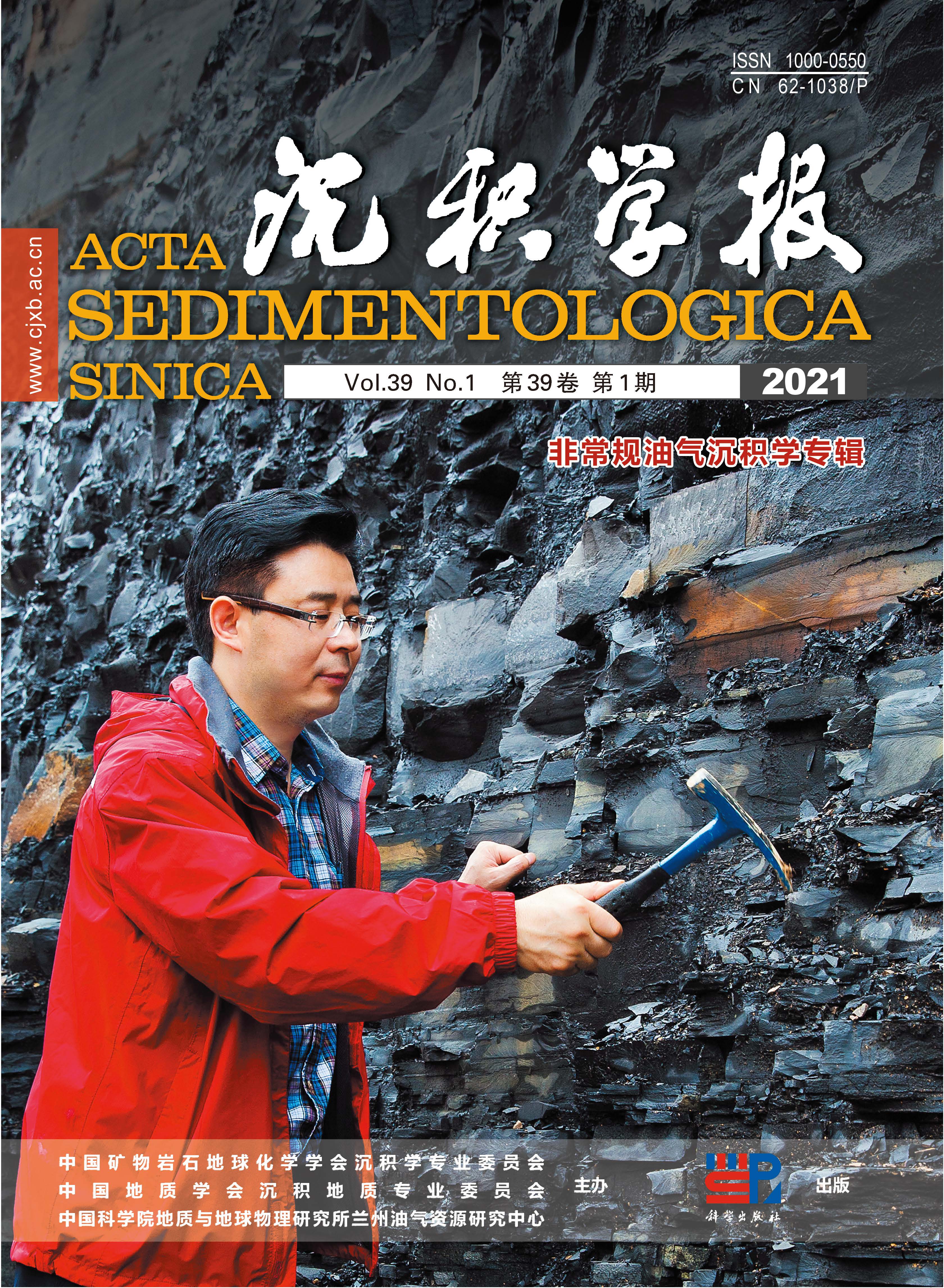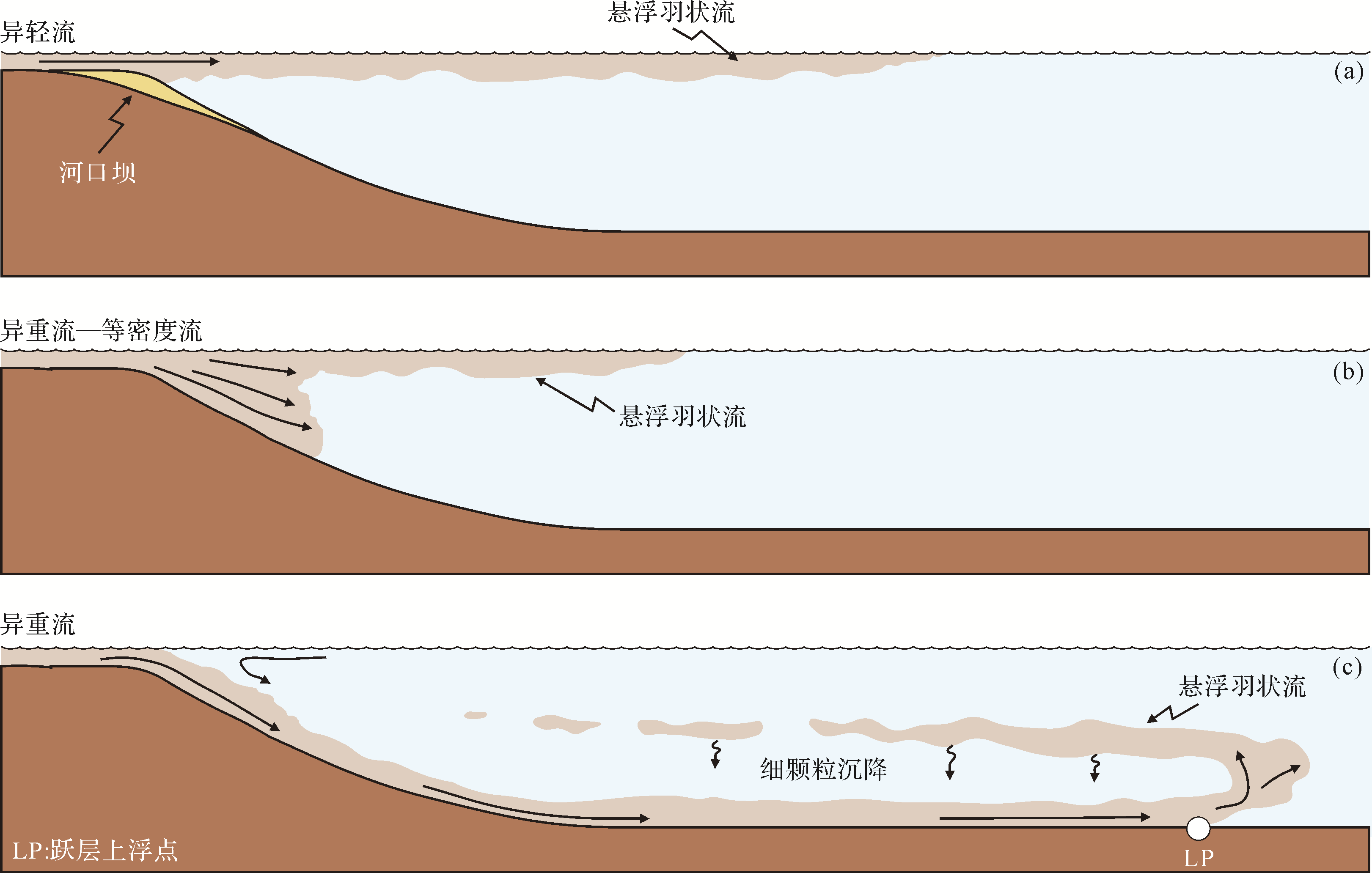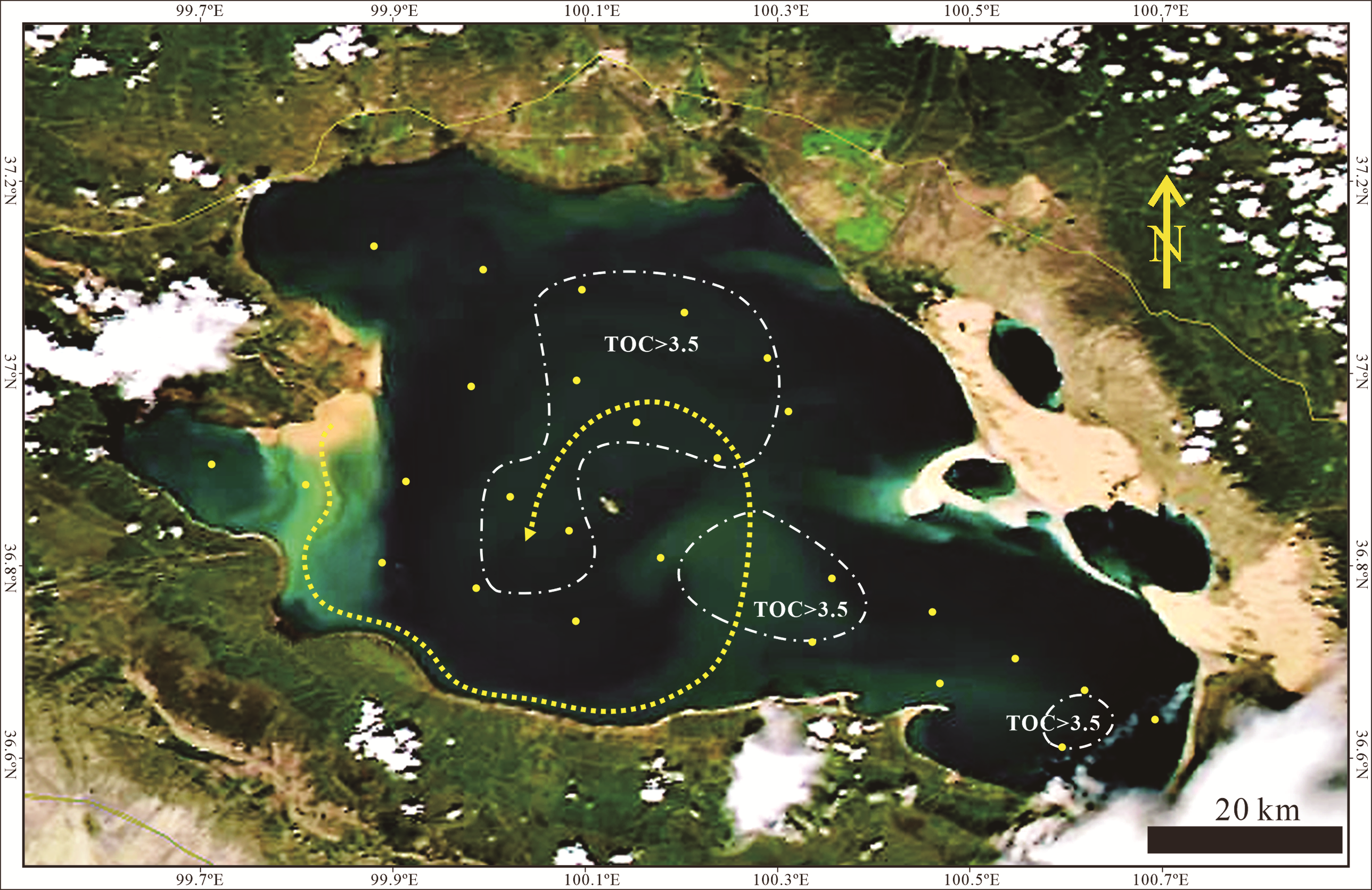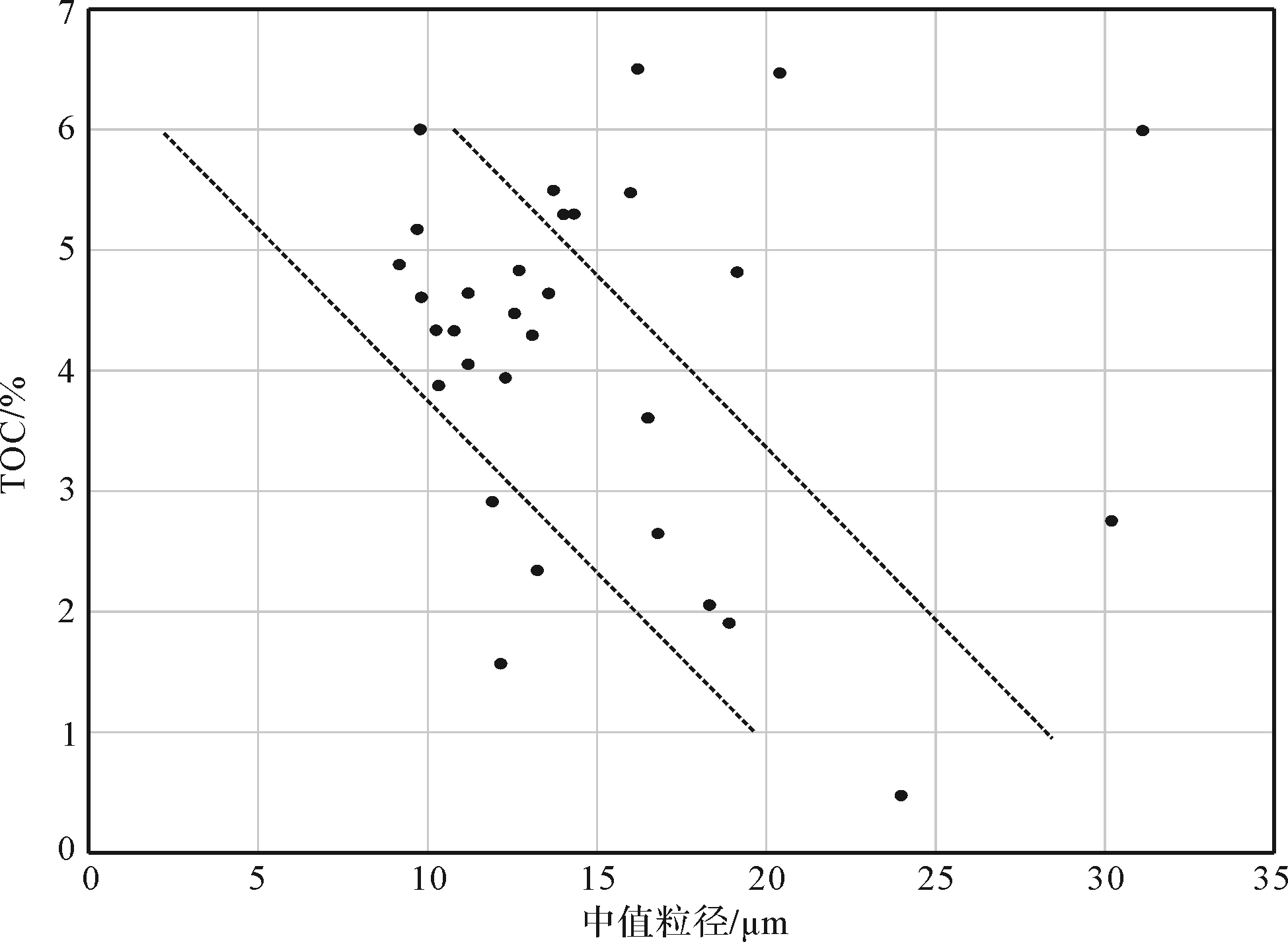HTML
-
沉积物理模拟通常指在限定的实验条件下,对自然环境中所发生的沉积过程进行模拟,以准确测定各种物理参数,并据此分析沉积物起动、输运、沉积和分布等的一种重要的沉积学研究技术。其发展及应用对于研究水利工程、环境科学、环境工程、土壤学、海洋学、古环境及油气勘探等具有重要意义。水槽是沉积物理模拟的主要载体,“水槽”一词源于拉丁文,现在泛指用于输送流水的倾斜槽道[1],广义的水槽还包括风洞、管路中的槽道及沉降管(或水池)等。自然环境可视为天然的“水槽”。早期沉积物理模拟实验多应用于工程技术研究[2],随后被广泛应用于沉积地质学、生物学和地质灾害防治等领域[3-6]。
前人利用水槽实验分别研究了无黏性沙和黏性土(或泥沙)的输运与沉积。其中,无黏性沙(>62.5 µm)主要由砂级和砾级颗粒组成,可进一步划分为无黏性均匀沙和无黏性非均匀沙两类;黏性泥沙主要由黏土(<2 µm)和粉砂(<62.5 µm)级颗粒组成,含有数量不等的有机质及少量细砂[7]。无黏性沙的运动和沉积相对简单,前人已建立一系列公式用于描述颗粒的运动属性(包括沉速、受力情况、起动条件和运动状态等)、水流的动力学特性(包括紊动、流速、阻力、挟沙力和流变学特性等),以及沙波的运动状态等[8-10],如斯托克期定律[11]、斯坦诺方程[12]、掺混长度理论[13]、水流及泥沙运动的连续性方程[14]、梅叶—彼德方程[15]、拜格诺方程[16]、爱因斯坦床沙质方程[17]等。因粒间的物理化学作用力(如化学键力、氢键力和范德华力)非常显著,颗粒易黏结形成絮团[18]和絮团集合体,这使得黏性泥沙的侵蚀、输运和沉积要比无黏性沙要复杂得多。前人在黏性泥沙的起动、输运和沉降等方面也开展了大量研究,并取得一批重要的成果认识[8-9, 19-27],但因影响因素众多,沉积过程复杂,多数成果仍停留在定性探讨阶段,相关问题仍有待深入研究。
当有机质含量足够高时,黏性泥沙即为石油地质关心的富有机质细粒沉积岩的前身物,其长期以来一直是石油地质学术界最为关注的研究对象[28-32]之一。近年来,随着非常规油气的快速发展,有学者呼吁将细粒沉积研究上升为“细粒沉积学”[33-34]和“非常规油气沉积学”[35-36]。细粒沉积物的概念由Krumbein[37]于1933年提出,特指多数颗粒直径<60 μm的碎屑沉积物,包括黏土(岩)、页岩、粉砂(岩)及冰碛物。细粒沉积岩是指以粒径<100 μm的颗粒为主(>50%),主要由黏土矿物和粉砂等陆源碎屑颗粒组成,或包含少量盆内生成的碳酸盐、生物硅质、磷酸盐等颗粒的沉积岩[38]。
众所周知,在地层记录中占比达2/3的细粒沉积岩[39]既包含了常规含油气系统的烃源岩,也包含了非常规含油气系统的烃源岩和储层。客观上,由于泥/页岩露头易遭风化,而且纹层过细,使得对细粒沉积岩的研究滞后于砂砾岩。目前,鉴于国内油气勘探开发与非常规油气沉积学发展的迫切需求,亟需对零星发表于沉积学、海洋学、地质学、环境科学、环境工程等领域的细粒沉积物理模拟成果进行系统的梳理与总结。笔者在系统调研前人基于水槽和沉降管(或水池)沉积物理模拟实验及现场观察与实测结果的基础上,以石油地质最关注的富有机质泥/页岩的沉积和保存为重点,从细粒沉积物(主要指黏性泥沙)的颗粒属性、侵蚀和沉积机制及底形特征、输运机制与沉积模式、有机质富集和保存机制等四个方面介绍细粒沉积物理模拟进展,以期探讨富有机质细粒沉积物的侵蚀、输运、沉积、保存与预测,从而深入研究泥/页岩含油气系统的源储特性,丰富和发展非常规油气沉积学理论[35-36],并为非常规页岩油气勘探部署和沉积古环境恢复等提供依据。对于理论上存在的无黏性细粒沉积物(如罕见的石英细粉砂等),因其在沉积过程中的受力情况与无黏性沙近似,相关沉积过程的研究可参照前述相对成熟的泥沙运动力学公式[8-9],本文不作探讨。
-
不同于无黏性沙,细颗粒因具有粒度细、浮重度小、比表面积大(如细砂为210 cm3/g,黏土为23 000 cm3/g)、表面通常带负电荷、离子交换容量大等特性[40],粒间的物理化学作用力(如化学键力、氢键力和范德华力)非常突出,相互之间极易黏结(絮凝)形成不同级次的絮团。细颗粒能否黏结在一起,在力学上取决于相互之间吸引力与排斥力的平衡,只有吸引力大于排斥力时,絮凝才会发生。颗粒间的相互作用力在根本上取决于自身的属性(黏性),通常只有黏性颗粒才能发生絮凝。黏性颗粒主要是黏土矿物,尤其是伊利石、蒙脱石和高岭石,这是因为它们通常具有粒度小、比表面积大(会对周围其他分子或原子产生吸附作用以最大限度地降低表面能)、易吸附水分子(因晶格中的氧及氢氧层均会与水分子形成氢键)、粒表常带负电荷(由同晶替代所致)等特性。由于所含原子及分子结构不同,黏土矿物的黏性差异极大,常见黏土矿物的黏性依次为蒙脱石>伊利石>高岭石。因表面带有不同数量的正电荷,一些金属氧化物也可引发絮凝,如常作为絮凝剂的铁氧化物[41]。不同于黏土矿物,石英和长石细颗粒虽然也是细粒沉积物的重要组成部分[9],但一般不具备这些属性,故通常无黏性。因此,通常认为细粒沉积物的黏性及与此相关的絮凝现象主要受控于所含黏土矿物的含量。当黏土含量>20%时,细粒沉积物通常具有明显的黏性,被称为黏性沉积物[41]。细颗粒的等容粒径和形状会对絮凝产生一定的影响,因为它们会对颗粒的沉速和扩散运动等产生影响,从而改变颗粒之间的距离,影响粒间的吸引力和排斥力。
絮凝的机理可使用胶体化学原理进行解释,因为携带黏性泥沙的水体(表现为固体分散在液体中)可视为胶体粗分散系统的悬浮液。据胶体化学原理[42]可知,悬浮液的基本特性是具有动力和电学性质。其中,动力性质表现为细颗粒的布朗运动、扩散及沉降;电学性质取决于细颗粒的带电性。颗粒表面的电荷主要来自于晶格缺陷和同晶替代等产生的永久电荷、表面化学反应产生的质子电荷、表面络合疏水物质或表面活性剂产生的络合电荷、吸附产生的电荷及电离产生的电荷等[43]。处于稳定状态时,悬浮液内部分散相粒子之间的各种动力和电化学力之间保持平衡,即排斥力和吸引力大小相等,方向相反。悬浮液能否发生聚沉(絮凝并沉积)取决于这种平衡状态是否维持。若流体发生流动或紊动,分散相粒子获得额外动力后粒间距离会发生改变,悬浮液会因粒间的吸引力超过排斥力发生絮凝和沉积。此外,向悬浮液注入一定数量(≥聚沉值)的电解质也会引发絮凝和沉积,因其会改变分散相粒子的双电子层结构[8-9],进而改变悬浮液的电化学性质。另外,因表面通常带有电荷,有机质(主要指藻类)的存在也会影响悬浮液的电学性质:当量少时会显著促进絮凝(称为敏化作用);相反,当量足够多时则会抑制絮凝,因为有机大分子吸附在胶粒表面可起到保护溶胶的作用。有机高分子化合物的絮凝方式包括搭桥作用、脱水效应和电中和效应3种。再者,将一些金属氧化物(如金属氧化物絮凝剂)加入悬浮液,也会引发絮凝[41]。
由上述絮凝机理分析可知,絮凝包括无机絮凝(盐絮凝)和有机絮凝(桥连絮凝和网捕絮凝)[44]两大类,所形成的絮团或絮团集合体既可以是纯的黏土矿物,也可以是有机质与无机物的复合体。后者与油气密切相关,是烃源岩的前身物。此类絮团通常是微生物群落、有机颗粒(如有机质碎屑、胞外聚合物、细胞及细胞碎屑)和无机颗粒的复合体,内部存在大量的孔隙空间及可自由出入或以束缚水形式充填于孔隙的水体[45-52]。在前人研究基础上,Droppo[52]于2001年提出了絮团的综合概念模型(图1),认为絮团由无机物、生物和有机质、水及孔隙组成,它们的相互作用影响着流体的流变学特征及颗粒的输运与沉积。

Figure 1. Conceptual model of the interrelationship of floc form and behaviour. The model shows the linkages between the individual components and their behaviors on overall floc form and behaviors(modified from reference[52])
室内实验和实地勘查表明:与细粒沉积物相关的絮凝条件极易满足。钱宁等[8],Chien et al.[9]和Migniot[53]认为粒径< 30 μm的细粒沉积物极易发生絮凝;Drake[54]研究表明2‰的盐度即可引发絮凝;Einstein et al.[55]得出盐度超过1‰即可引发絮凝;Busch et al.[56]研究得出0.5 mg/L的有机高分子聚合物足以引发絮凝,1 mg/L可使絮凝达峰值;Laane[57]实地勘查表明,具絮凝现象的水体所溶解的碳水化合物可低至0.1 mg/L。在自然环境中,这些临界条件之上形成的个体絮团直径通常介于50~1 000 μm[58],不易被肉眼察觉,但其群体极易观察,如直径可达数米的絮团集合体[59]及大面积分布的赤潮等。
前人的观察和研究表明,海洋具有极佳的细粒沉积物絮凝条件:首先,较高的盐度可提供充足的电解质;其次,现今入海的沉积物64%以悬移质输运[60],这为絮凝的发生提供了充足的黏性颗粒;再次,海洋透光带浮游植物年生产力达500亿吨[61],海水中溶解的有机质(Dissolved Organic Carbon)高达6 620亿吨[62],这为絮凝提供了充足的有机“黏合剂”。与海洋相比,湖泊藻类发育更为繁盛(如太湖、滇池等[63]),雨季河流悬移质浓度更高[60],也不乏咸化湖泊(如青海湖),这表明湖泊也具有很好的絮凝发生条件。这或许是海洋和湖泊环境极易观察到絮凝现象的原因,如埃姆斯河河口[64]、莱茵河河口[65]、易北河河口[66]、德拉华湾[67]等海洋或河海过渡环境,以及阿波普卡湖和太浩湖[68]、利洛埃特湖[69]、太湖和青海湖等。
絮凝发生后,以絮团形式存在的细粒沉积物具有不同子细颗粒个体的动力学属性,携沙流的流变学性质也会发生不同程度的变化。这些变化既会影响沉积物(包括有机质)的侵蚀、输运和沉积过程,也会影响沉积物的组分、结构、沉积构造和展布等。因此,就细粒沉积物开展絮凝及沉积过程研究,对沉积环境解释及油气烃源岩评价和非常规油气勘探都具有重要意义。
-
与无黏性沙相比,细颗粒(黏性颗粒)在迁移与沉积过程中的受力情况在本质上没有区别,都受重力、浮力、拖曳力(床面剪切力)、上举力、黏结力(cohesion force)、粒间离散力、渗透压力及物理化学力(如化学键力、氢键力和范德华力)等作用[8-9]。但是,因细颗粒之间的黏结力和物理化学作用力突出,细粒沉积物从侵蚀到沉积的过程都表现出不同于无黏性沙的特征,所形成的底床形态也有所差异。
-
黏性颗粒能否被侵蚀,取决于上举力和起动拖曳力(床面剪切力)的合力是否大于颗粒的起动阻力(主要是粒间摩擦力和黏结力),只有起动的合力大于阻力时,颗粒才能离开床面并随流体运动[8-9]。该过程及作用机制十分复杂,同时受控于床面近壁区的紊动猝发作用及细粒沉积物的微观组构。紊动猝发现象的产生是因为流速梯度大的床面周围(近壁低速层流层)会发生紊动并形成涡流,该涡流在流速压差作用下会离开床面上升并被水流带向下游,直至崩解。该涡流上升过程称为低速带举升[8-9]。与低速带举升相伴的是来自主流区高速流体对边壁的扫荡。据Offen et al.[70]观察,在每一次低速带的举升之前,都有一个来自上游主流区的扰动,该扰动就像漩涡,具有向边壁方向的平均运动。通常认为低速带的举升和高速流体的扫荡互为因果,两者以一定的发生概率交替出现[8-9]。在来自主流区间歇性高速流体的扫荡下,分布于床面的颗粒(包括单颗粒和絮团)将受到瞬时剪切力作用。若该剪切力与上举力的合力大于阻力,细粒沉积物(单颗粒或絮团)将被侵蚀,并随紊动猝发体(如U形环涡流[8-9])的低速带自床面附近上升,直至转入沉降阶段;反之,床面将保持稳定。
由上述可知,细粒沉积物(包括固结及未固结的)的侵蚀主要取决于两个方面,一是外在的水动力条件,二是颗粒间及其与床面的作用力。前者对沉积物施加床面剪切力并引发上举力[8-9],其大小主要取决于水流的能量及流态(如是否为紊流);后者受诸多因素影响,包括颗粒自身的属性和流体的物理化学性质等。对于细粒沉积物侵蚀的认识是一个不断深化的过程:早期认为主要取决于临界流速、临界剪切力[71-72]或临界抗剪切强度[73];后来认识到还与沉积物的极限含水量(atterberg limit)和宏观强度(macroscopic strength)等[74-75]相关;随后,进一步认识到还受沉积物的密度、孔隙度、含水饱和度、固结时间(程度),表层沉积物中絮团的密度、结构及其与下伏沉积层的作用力,黏土矿物的类型、排列方式和含量,以及水体的温度和所含的电解质等影响[41,76-77]。其中,固结作用主要发生于准同生期,对细粒沉积物的抗侵蚀强度有很大的影响。在此期间,因为絮团的结构不断发生调整,细粒沉积物会从不稳定向亚稳定转变。据Partheniades实验分析[78-79],絮团在准同生期的固结过程可划分为4个阶段(文献[41]中图3.15~3.18):首先,沉积的絮团集合体相互连接构成溶胶;其次,在上覆沉积物重荷作用下,絮团集合体因相互之间的孔隙空间消失而趋于相互接触;再次,絮团集合体内部孔隙空间逐渐消失,絮团之间趋于相互接触;最后,随着细颗粒之间的结构发生调整,絮团内部的孔隙空间也趋于消失,细粒沉积物进入亚稳定状态。固结程度不同的细粒沉积物通常表现出不同的抗剪切强度及抗剪切强度—深度关系,弱固结者的抗剪切强度随深度增大明显上升,完全固结者则无明显变化。Mehta et al.[80]的系列实验证实了这种解释,与沉积后静置2 h者相比,絮状物静置240 h后固结程度显著上升(厚度下降44%,平均密度增大60%),相应抗剪切强度上升约16倍[41]。因此,固结的细粒沉积物和新淤积的软泥有着不同的侵蚀特征。假定床面剪切力(略大于侵蚀临界剪切力)恒定,随着时间的推移,固结的细粒沉积物会被持续侵蚀,直至消失殆尽;软泥的侵蚀则随着侵蚀深度的增大逐渐减慢,直至停止。

Figure 2. A Schematic diagrams showing main steps of the conceptual evolution model of a single sustained hyperpycnal discharge(modified from reference[109])
-
当细粒沉积物(单颗粒或絮团)受侵蚀而离开床面并随紊动猝发体的低速带上升后,将转入输运或沉积阶段。假定流速不变,该阶段细粒沉积物的沉积主要受控于沉速:若沉速大,其在上升过程中会很快落到低速水团外,并重新回到床面;若沉速较小,其会随着低速水团的漩涡持续上升,直至低速带崩解时升至最高点,转而开始下沉;若沉速极小,其会随低速水团的漩涡上升至主流区并以冲泻质[8-9]输运,最终沉积于静水区。在降落过程中,一部分细粒沉积物会被正在向床面运动的高速带捕获,并回到近壁区;另一部分则可能被卷入上升低速带中的漩涡并随之再次上升,随后进入下一个沉降周期。高速带在扫荡至床面后将向两侧散开,在两股高速带之间形成一股新的向上抬升的低速带,随高速带下落的细粒沉积物也在床面附近被推向两侧,进入另一个低速带并进入新的运动周期。由此可知,沉速对细粒沉积物的沉积起至关重要的作用。
因为黏土级颗粒的静水沉速仅为0.003 mm/s[81],在未发生絮凝或絮凝不显著时,通常认为输运中的细颗粒极易受到水流的紊动(即便是微弱的紊动)影响,并随低速水团的漩涡上升至水流高速带。只要满足沉速小于上升低速带的流速,即使流速缓慢,细粒沉积物都以冲泻质[82]输运并最终沉积于静水区。与此不同,发生絮凝后,细粒沉积物主要以絮团的形式存在,其沉速可达0.01~2 mm/s或更高[53, 83-87]。此时,细粒沉积物的输运和沉积将发生显著变化:沉速偏大的絮团因具有类似于无黏性沙的属性,即使流速较大,也趋向于以跃移质或接触质输运,并在输运过程中经历周期性上升和下落;沉速中等的絮团趋向于以悬移质输运,并随水流紊动减弱向跃移质或接触质转变;沉速偏小的絮团趋向于继续以冲泻质输运。由此可知,细粒沉积物既可以冲泻质沉降于静水区,也可以床沙质(主要是絮团)在牵引流(床面剪切力)作用下沉积于较强的水动力环境(如滨岸带和河道侧翼等)。这种观点已被模拟实验[88]证实,即细粒沉积物絮团在高达20 cm/s的流速下也可沉积形成沙纹,而这样的流速通常被认为只有砂级颗粒才能沉积。在开展泥/页岩研究时,需要特别关注细粒沉积物的这种特性,因其会使细粒沉积岩的岩性变得异常复杂,从而降低依据岩相来解释沉积环境的可信度并影响非常规油气泥/页岩甜点段/区的优选。
由上述分析可知,在输运和沉积过程中,细粒沉积物与无黏性沙在本质上并无区别,只是前者的过程更为复杂,体现为颗粒(或形成絮团)的沉速是变化的。未发生絮凝时,颗粒的沉速主要受浮重度和粒度控制,颗粒通常以冲泻质最终分散沉降于静水区并形成平直平行纹层。相反,絮凝形成的絮团具有变化的沉速,颗粒或可沉积于较强的水动力环境并形成不同尺度的沙波,具体主要取决于沉速。絮团的沉速同时受絮团自身的属性(如大小、密度、组分和结构)、水体的物理化学属性及水动力(如剪切力)控制。前两者会对絮团内部颗粒间的作用力产生影响,进而影响絮团的稳定性(抗剪切强度)及沉速。例如,通常认为大比重细颗粒(如粗粉砂)越多(未引发絮团崩解之前),絮团越易沉积;反之,则相反。水动力对絮团的影响较复杂,当小于絮团的抗剪切强度时,剪切力越大,絮团越多、越大、越易沉积;反之,则絮团越不稳定、越小、越不易沉积。
-
由前述可知,黏性泥沙的侵蚀和沉积过程与无黏性沙并无本质区别[8-9],而且在该过程中同样进行着悬移质、接触质/跃移质、层移质、床沙质之间的相互交换。因此,细粒沉积物所形成的床面底形(沙波)[8-9]与无黏性沙不会有特别大的差异,随着流速从低于临界流速开始持续增大,将依次经历静平行、沙纹、沙垄/丘、过渡、动平行、沙浪、碎浪、急滩—深潭8个演化阶段[89]。但由于絮团的粒径和发生侵蚀的临界剪切力之间的关系复杂,且颗粒之间黏结力大,细粒沉积物沉积之后再次起动需要更大的床面剪切力(>发生沉积时的床面剪切力)[8, 26],故形成的底形会有所差别。目前,尽管这方面的研究较少且不成系统,但已取得一些重要认识。例如,在宏观上,实验实测表明,与无黏性沙相比,随着所含黏性颗粒的增多,细粒沉积物的床沙底形趋于更稳定,沙波的尺寸趋于变小甚至不发育[90-92];当床沙含有机高分子化合物或被生物被膜覆盖后,这种现象更为显著,床面甚至不发育沙垄等沙波[90, 93-101]。在微观上,细粒沉积物形成的纹层其倾角更大,通常可达休止角[91]。尽管细粒沉积物底形的研究程度还较低,但已取得的研究成果足以表明絮团的沉积对沙波形态的影响或超出预期。例如,Baas et al.[91]的研究表明,在同等实验条件下,干样泥/沙比值为1.2%~3.2%的细粒沉积物,其沙波高度仅有纯细砂(中值粒径为143 μm)的0.03%~26%;Malarkey et al.[100]的研究则表明,重量达床沙重量0.063%(河口湾的基值)的有机质足以对底形产生显著影响。此外,黏性颗粒的存在还使得固结—半固结的细粒沉积物易形成独特的冲刷构造,即床面易形成侵蚀坑并堆积从床面撕裂出来的黏结团块[8-9,102]。当床面覆盖生物被膜时,这种现象更为明显[100],尤其在表面生物被膜厚度超过1 mm后。
细粒沉积物底形的这种特征对于沉积环境的判断可能影响不大,但会显著影响沉积亚环境(subenvironment)的判断,尤其是低估沉积环境的水动力强度,如将三角洲内前缘解释为外前缘,抑或将内陆棚解释为外陆棚。这种沉积亚环境的误判对于非常规油气泥/页岩甜点段/区的成因分析和优选或有重大影响,有待深入剖析。
2.1 细粒沉积物的侵蚀
2.2 细粒沉积物的沉积
2.3 细粒沉积物的底形特征
-
泥沙越细,其浮重度越小,因此细粒沉积物通常以悬移质输运,甚至以冲泻质[8-9, 82]输运。这已得到全球流域水文统计数据[103]的印证,即全球输入海洋的河流负载沉积物72%为悬移质。Mulder et al.[60]分析了河流的率定曲线,得出河流沉积物(包括床沙质和悬移质等)的输运绝大多数发生于洪水期。例如,大型河流的Ms2值(全年悬移质通量最高的2%时间累积的悬移质通量与全年总量的比值)通常约为20%,小型山区河流的Ms2值普遍高达50%~70%[60]。洪水从河口注入湖泊或海洋后,由于水深增加,流速下降,所携带的泥沙较粗的一部分就近沉降形成三角洲前积层,较细的一部分由于沉速较慢,仍以悬移质继续输运。Sturm et al.[104]认为该悬移质可形成异轻流(表层流体)、等密度流(层间密度流)和超密度流(异重流/底流)三类洪水重力流,具体类型取决于河流和汇水盆地之间水体的密度差。其中,异重流特指流入淡水或咸水盆地水底的地表携沙流,它将地表环境和水下环境联系在一起[105-107]。其典型特征是源自陆上,完全为湍流,移动速度相对慢,持续时间长(几周或几个月),移动距离可达数百千米[107-108]。Zavala et al.[109]总结了异重流的发育过程,将其划分成8个阶段(图2):1)注入洪水密度小于海水时,形成异轻流(图2a);2)洪水聚集至密度等于海水时,形成等密度流(图2b);3)和4)洪水聚集至密度大于海水时,河水冲入海底并将先存羽状流和表层水体吸收并卷入海底,形成异重流(图2c);5)至8)随着注入洪水密度下降,LP逐渐向陆一侧移动,三角洲体系恢复至以异轻流为主的初始状态。Mulder et al.[106]分析了全球主要河流的水文数据库,认为流入海洋的河流径流71%可产生异重流,频率是每年一次(混浊的河流)至每百年一次(清澈度中等的河流)。据Parsons et al.[110]实验观察,异轻流和等密度流均会向异重流转变。据此,可认为源自陆上河流的细粒沉积物及其吸附的有机质通常以悬移质的方式通过洪水输运,并且主要以洪水异重力流在湖盆或海盆内长距离输运。
除了持续时间长的洪水重力流,由雷雨或飓风等瞬时气候事件形成的短暂性洪水,以及地震、海啸等相关垮塌事件所形成的涌浪型浊流(如沉积经典鲍马序列的浊流)也可输运细粒沉积物。其典型特征是流体的能量快速减弱[111](即流速迅速下降),因此所携带细粒沉积物的输运距离远小于持续时间长的洪水重力流。
尽管触发机制有所差异,但重力在携沙流中所起的作用是公认的,即便是水流其能量也主要来自重力势能。因此,在广义上,沉积物输运流体都可以称为重力流。对于重力流流体的动力学或流变学特征,前人已开展了大量深入的研究[112-123]。例如,Middleton et al.[115]依据支撑机制将重力流划分为泥石流、颗粒流、液化沉积物流和浊流;Lowe[116]按流变学特征将重力流划分为低密度浊流、流体化流、过渡液体流、颗粒流和黏滞流,前两者属于流体流,后两者属于塑性流;Mulder et al.[117]依据流体的属性和颗粒支撑方式进一步将重力流分为浊流、密度流、超密度流和碎屑流。对于重力流的演化过程,通常认为由于水体的掺混,其会从塑性块体流逐渐转化为碎屑流,然后再转化为浊流[118]。但是,更多的研究表明,重力流在输运过程中既可以从湍流(如浊流)经过渡流向层流(如塑性碎屑流)转变,也可以从层流向湍流转变,并形成重力流混合沉积[119-121]。
细粒沉积物颗粒会抑制流体中的湍流,进而对重力流的动力学和流变学属性产生重大影响。随着黏性颗粒浓度增大,重力流会相继从湍流转变为过渡流和亚稳定层流[122-123],相应流体的流变学属性从牛顿流体向伪塑性—塑性流体转变,进而影响沉积物的分异、沉积和展布。此外,细粒沉积物颗粒还会影响重力流的动力学特征,如使其流速下降、输运距离缩短[124]。
不同输运机制形成的细粒沉积物/岩可用不同的沉积模式描述。异重流所形成的异重流沉积(岩),其相序特征是流量上升期形成反粒序层,流量下降期形成正粒序层,两者内部均可见牵引流和悬浮沉降沉积交替构成的复合层,其沉积相模式由Mulder et al.[108]建立。涌浪型浊流形成经典的鲍马序列[125],其相序特征是总体向上变细,自下而上依次发育块状砂岩粒序层(Ta)、平行纹层砂岩(Tb)、沙纹层理细砂岩(Tc),以及粉砂和半远洋泥(Td和Te)。该沉积序列以Td和Te为主要的细粒沉积亚段。因触发机制可交替出现或重叠,异重流和浊流沉积可交替分布,甚至重叠,如Saguenay峡湾及与瓦河相关的重力流沉积[60]。此外,还有一些沉积模式也可用于描述细粒沉积岩的岩相及沉积过程,如主要用于描述细粒浊积岩的Stow序列[126]及用于描述深水重力流混合沉积的Haughton序列[119-120]。其中,Stow相序总体也向上变细,自下而上依次为T0底部透镜状纹层,T1包卷纹层,T2波状—透镜状纹层,T3规则薄纹层,T4模糊纹层,T5束帚状粉砂纹层,T6有粒序变化的泥岩及粉砂岩透镜体,T7无粒序变化的泥岩,T8含小型生物扰动构造的泥岩。
-
就全球碳循环而言,有机质(初级生产力)的埋藏率非常低。以海洋为例,据Kandasamy et al. [61]总结,全球初级生产力约为1 100亿吨/年,海洋初级生产力约为500亿吨/年,但埋藏于海洋沉积物中的有机碳仅为1~2亿吨/年,约占前者的0.1%,约占后者的0.2%。通常认为有机碳的埋藏主要受初级生产力、沉积速率、底水含氧量和有机质来源等因素控制[61,127],但仍有待进一步研究。前述细颗粒的絮凝特征分析表明,细粒沉积物与有机质易相互黏结形成絮团,这可能会对无机细颗粒和有机质的沉积过程及分布产生重大影响。这种影响体现在两方面,一是有机质对无机细颗粒的影响,二是无机细颗粒对有机质的影响。
有机质对无机细颗粒的影响至少有三个方面:一是促使长期处于悬浮状态的细颗粒发生絮凝,进而形成絮团并沉降,这有利于细颗粒的沉积范围扩张至静水区之外的较强水动力环境(如下临滨);二是影响富细粒沉积物重力流(如异重流)的动力学特征,如降低其流速和输运距离[124],从而影响细粒沉积物在空间上的分布及沉积体的形态(如席状或透镜状);三是提高絮团及絮团沉积物的抗剪切强度,从而使细粒沉积物少受或免遭侵蚀,尤其是沉积于水动力较强环境的细粒沉积物。
无机细颗粒对有机质的沉积和保存的影响主要体现在三个方面:一是吸附有机质形成絮团,从而使密度较小的有机质获得更大的沉速并脱离富氧水体,免遭进一步的生物降解及氧化分解;二是湖/海盆中沿特定路径迁移的含无机细颗粒重力流—絮状物羽状流(图3)会以絮凝的方式对透光带中的藻类有机质进行“收割”,并沿途沉积富有机质细粒沉积物;三是黏土矿物与有机质结合后可提高有机质的稳定性,从而有利于有机质保存。这三个方面的影响详述如下:
(1) 有机质的沉积
由于密度普遍偏低,甚至小于海水[128],个体有机质的下沉通常非常缓慢,故其在死亡之后漫长的下沉过程中会遭受细菌等微生物降解和氧化分解。有机质沉降之后,从水底表层至脱离成岩活跃带(diagenetic active surface zone)还要遭受进一步分解。因此,有机质(初级生产力)的沉积率通常非常低。以海洋为例,通常认为颗粒状有机质(Particulate Organic Carbon)只有极少数大颗粒(如粪球粒和直径>200 μm的絮团——生物雪)能够沉降至海底[129-131],多数颗粒在沉降程中受细菌拓殖等影响会逐渐变小直至完全降解。海水中与颗粒状有机质并存的溶解有机质(浓度约34~80 μmol/kg,数量高达6 620亿吨)通常被认为更难沉积于海底并保存[62]。然而,前述细颗粒的絮凝特性分析表明,细粒沉积物极易与有机高分子化合物黏结形成絮团,从而提高有机质的沉速并使其脱离水体,故可认为细粒沉积物有利于有机质沉积。这种解释可从已发表的文献中找到依据,例如Tyson[131]的研究表明,在有机质被铝硅酸盐颗粒稀释达临界值(约为5 cm/ka)之前,沉积速率与总有机碳(TOC)呈正相关关系。据此可认为,频繁发生的河流洪水重力流(见前述)在注入沉积盆地并进一步与水体中的藻类等有机质接触后,会引发广泛的絮凝并促进有机质沉积。有机质的这种沉积方式或可随季节变化在广泛的区域内反复发生,从而显著提高有机质的埋藏数量及埋藏率。这可能也是全球碳循环概算得出大陆边缘2 000 m以浅区域[132]或三角洲[127]所埋藏的有机碳在海洋有机碳总埋藏量中占比超过40%的原因。
(2) 有机质的富集
依据细粒沉积物易与有机质发生絮凝并以洪水重力流作为主要输运机制的特性,结合现代青海湖的研究(图3),笔者提出一种新的富有机质细粒沉积富集假说:首先,在雨季,高含细粒沉积物的洪水入湖/海后会形成重力流(包括异重流/等密度流/异轻流);其次,该重力流(絮状物羽状流)在惯性力、湖/洋流(如风驱湖流)等作用下沿特定路径流动,并在流动过程中以絮凝的方式对透光带中的藻类等有机质进行“收割”,同时沿途沉积富有机质细粒沉积物;最后,当絮状物羽状流推进并消亡于浪基面之内的半深湖—深湖区时,由于沉积速率高、含氧量低、后期改造弱等,有机质将在絮状物羽状流的消亡区富集。有机质的这种富集过程在青海湖非常明显:首先,洪水期可观察到沿逆时针方向流动的絮状物羽状流;其次,湖底表层沉积物实测的TOC高值区与絮状物羽状流的迁移路径吻合良好(图3)。据此可认为,富有机质细粒沉积物的富集可能主要受絮凝作用、洪水重力流、低含氧环境(浪基面之下)和高沉积速率共同控制。
目前,洪水重力流[60]仍是沉积学界一个较新的概念,其研究程度还较低,与其相关的有机质富集探讨较少,研究还有待深入。此外,在潮汐、海浪等作用下,已沉积的细粒沉积物会遭受侵蚀或发生垮塌,进而以涌浪型低密度浊流再次发生沉积(如Stow序列),从而改变有机质的富集,其机理尚鲜有人探讨。
(3) 有机质的保存
有机质在不同沉积环境中的保存或有不同的主控因素,但有机—无机作用或是最为重要的控制因素之一,因为海相超过90%的沉积有机质都以有机—无机复合体(或称有机黏土复合体)存在[127]。细粒沉积物对有机质保存的影响可能主要体现在两个方面:一是增强有机质的稳定性,并通过隔离水解酶使其具有更强的抗生物降解能力;二是阻止氧气输送和流体渗流,从而抑制有机质的氧化和喜氧生物的降解。
在有机黏土复合体中,有机分子进入黏土矿物层间呈定向排列后会变得更稳定,从而更能抵抗生物降解。Armstrong et al.[134]的研究表明,明胶与蒙脱石复合体的分解速率远小于分散的明胶与蒙脱石混合物。一些间接证据也支持这种解释:有机黏土复合体中的部分有机质无法使用普通的有机溶剂萃取,需用氢氟酸破坏黏土矿物的结构后才能分离[135]。有机黏土复合体通常还具有更高的热稳定性,从而有利于有机质保存。例如,Block et al.[136]的实验表明有机质(肽)与蒙脱石结合后热稳定性显著上升。因此,许多学者认为黏土矿物可使有机质变得更稳定,从而使其少受或免遭生物降解[137]。前人在机理方面也进行了探讨。Mayer[138]分析了比表面积与有机质含量的关系后提出微孔有机质保护假说,认为不止是黏土矿物,其他细粒沉积物也有利于有机质的保存,因为细粒沉积物表面的微孔(孔径小于8~10 nm)可阻止有机质降解所需的水解酶与有机质充分接触,从而有利于有机质保存。Clark认为细粒沉积物的微孔隙结构还可抑制水解酶的活性,从而保护有机质,因为有机分子与矿物表面化学吸附键的强度已接近共价键的强度[139]。
不同于渗透性好的砂岩,细粒沉积物压实后为低渗或非渗透层,可阻隔下伏的有机质与富氧的底层水。这既可降低有机质直接的氧化分解,也可抑制喜氧生物繁殖,从而有效抑制有机质的生物降解。
上述细粒沉积物与有机质之间的共存关系充分体现在有机质含量与沉积物粒径之间良好的负相关关系上。例如,郭志刚分析了东海的表层沉积物[140],得出沉积物粒度和有机碳具有极好的负相关关系,即泥质沉积区有机碳含量最高,砂质沉积区有机碳含量最低。当代湖底表层沉积物TOC与粒径之间也有良好的负相关关系。如图4所示,不考虑水深、湖流、河流等影响因素,除了少量数据可能取自发育生物席的水流淘洗粗化区之外,多数数据(虚线夹持区间)显示,青海湖湖底表层细粒沉积物的中值粒径与TOC有良好的负相关关系。油气钻井揭示的古代烃源岩层也显示有机质主要赋存于细粒沉积岩中,如东部歧口凹陷第三系的孔店组、中部鄂尔多斯盆地的延长组及西部准噶尔盆地的芦草沟组等。
-
细粒沉积物因所含颗粒的粒度细、浮重度小、粒间物理化学作用力强,极易发生絮凝,从而具有不同于无黏性沙的水动力学、沉积学和岩石学特征。
(1) 细颗粒的水动力学特征较无黏性沙要复杂得多,颗粒个体多以冲泻质输运并沉降于静水区形成平直平行纹层;颗粒集合体(絮团)则具有与沙粒相似却不完全相同的特征,可沉积于较强的水动力环境,形成较小、较稳定的沙波。从受力情况来看,细粒沉积物的侵蚀、输运和沉积过程与无黏性沙并无本质区别,只是过程更为复杂,影响因素更多,尚无准确的描述公式。
(2) 细粒沉积物通常以悬移质输运,主要通过河流洪水输运至湖泊/海洋,洪水异重流和涌浪型浊流是其主要的输运机制。
(3) 细粒沉积物易与有机高分子化合物黏结(絮凝)形成絮团,进而影响有机质的沉积、输运、富集和保存,这对油气烃源岩评价和非常规油气勘探有重要影响。
由于颗粒属性特殊,粒间物理化学作用力复杂,沉积过程难以准确表述,对细粒沉积物的研究已远远超出传统沉积学的范畴,其沉积过程与沉积产物的准确表征应上升到非常规油气沉积学甚至地球系统科学高度。对于非常规油气勘探,应组建多学科联合攻关团队综合分析各种造就富有机质页岩沉积的地质耦合事件。就细粒沉积物理模拟而言,应从研究内容、技术手段和应用三个方面加强。
(1) 在研究内容上,除了开展高岭石和简单的有机—无机絮凝及沉积过程模拟之外,应增加其他常见黏土矿物(如蒙脱石、绿泥石及混层黏土矿物)及复杂的有机—无机(不同类型的黏土矿物及有机质)絮凝及沉积过程模拟,以全面分析自然界中真实存在且普遍发生的沉积作用;对于沉积物的底形、沉积构造及其沉积期后变化应开展系统性研究,以全面了解细粒沉积物中沉积构造的水运力与沉积环境意义,从而为古地理恢复等提供准确的依据;对于输运机制,应深化湍流状态下细粒沉积物的侵蚀、输运和沉积过程研究,完善相关的经验与半经验公式。
(2) 在技术上,应引进新的技术与设备(如三维激光微地形扫描仪),同时建立大尺度、长周期物理模拟实验平台并与数值模拟结合,从而为重力流、波浪、潮汐流等条件下的细粒沉积物模拟及泥沙运动方程和数学模型的完善奠定基础。
(3) 在应用方面应加强细粒沉积物理模拟在非常规油气勘探中的应用,泥/页岩的纹层成因和有机质富集规律等均可以通过模拟实验进行探讨,从而为页岩油/气的“甜点”段/区优选提供依据。
总之,细粒沉积物及其物理模拟研究方兴未艾,其研究成果不仅能丰富非常规油气沉积学的内涵,而且可以指导油气勘探,还可以服务于环境保护、海岸防护等民生工程,甚至有助于全球气候变化研究(碳循环研究),希望更多的有识之士对其产生兴趣并推动研究深入。









 DownLoad:
DownLoad:


